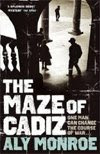A recent blog entry by Spanish writer Miguel Aranguren, talking of the effect of the financial crisis on the Spanish, is entitled De Solomillo a Sopa de Ajo, From Tenderloin to Garlic Soup. This sparked off a number of memories.
The first was of Juan, my butcher in Cadiz, around the time Franco died. The poorer women who frequented his shop usually bought lumps of pork fat or cooking chorizo to add to their potajes of broad beans, chick peas or lentils. They were unhealthily fat, their children skinny with generations of deprivation engraved in their faces. Newly-confident, newly left-wing Juan would patiently explain that times were changing, and that they must give their children a better chance in life than they had had. To feed a child properly, he said, they must continue with the nourishing pulses but, several times a week they should also give them a good piece of steak - and, he added, “if you can afford it, el solomillo es rey” - tenderloin is king.
Given the eagerness of many of the women to be seen to be giving their children a better life, you might think that Juan’s business would be thriving. And for a time it was. Times were getting easier for a lot of people, and sales of steak shot up.
But there were still those souls who lived among the rubble in the nearby, ruined bull ring, who had no means of support. I remember one tiny bent old woman called Angelines. She would sometimes appear at the door of the butcher’s shop in her grimy black clothes and frayed slippers, and stand there until Juan called her in. He would then wrap something in paper - a marrow bone, a couple of sausages, perhaps a bit of cured ham. Angelines would extract a long tear of grey paper from somewhere among her clothes and Juan would add the amount ‘owed’ to the already long list. When the paper ran out he would tear it up and begin a new one.
Angelines did not eat solomillo. If she was lucky enough to have some oil, she might have eaten sopa de ajo, which consisted of gently frying some thinly sliced garlic cloves in a little olive oil until soft, adding hot water - or, if you had it, chicken stock - and some broken pieces of semi- stale country bread, and simmering gently.
One of the most famous Spanish soups is called Ajo Blanco (White Garlic). It’s really Cold Almond Soup - sometimes called white gazpacho - and was often served by some of my Spanish friends in Easter week.
In The Maze of Cadiz, following an over-rich meal at the house of an ex-pat couple, Peter Cotton suffers a violent bout of gastroenteritis. On his way to recovery – having drunk lots of camomile tea on the doctor’s orders – he is brought a bowl of almond soup followed by some lightly grilled chicken.
Now this soup might have been a simple Leche de Almendras - almond milk - which is often given to convalescents as a nutritious restorative, but I like to think it was Ajo Blanco. It makes a refreshing starter, or a simple supper served with strips of serrano or parma ham.
Here is the recipe:
Ajo Blanco con Uvas - White Gazpacho
Ingredients
200 grams semi stale country-style bread, crusts removed
200 grams almonds, blanched and skinned
3 cloves garlic
150 ml extra virgin olive oil
5 tablespoons wine vinegar
2 teaspoons salt
1 litre water
150 grams crisp white grapes, seeded
Method
Soak the bread in water until softened, squeeze it out and put in a blender or processor with the almonds and garlic. Blend to a smooth paste, adding a little water if necessary. With the motor running, add the oil in a slow stream, then the vinegar and salt. Beat in some of the water, then pour the mixture into a tureen, wooden bowl or pitcher and add the remaining water. Taste for seasoning, adding more salt or vinegar if needed. The soup should be fairly tangy. Chill. Stir before serving into bowls garnished with the grapes.
(Small chilled scoops of melon are sometimes used instead of the grapes)
Monday 16 March 2009
Subscribe to:
Posts (Atom)






